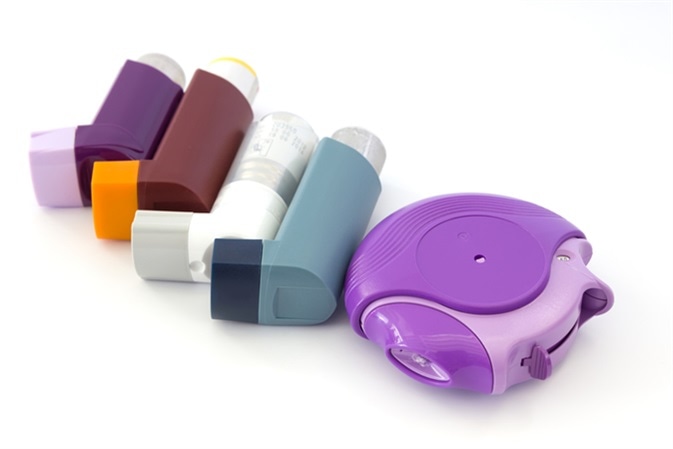Inhalers are handheld devices used to deliver medication to the respiratory tract in chronic obstructive pulmonary disease (COPD) and asthma. They are used both for the prevention and treatment of exacerbations of these chronic conditions. They offer the benefit of avoiding systemic exposure to drugs, while ensuring that the drugs go directly to where they are needed (i.e. the lungs).
The first such device was sold in 1948, by Abbott Laboratories, but it was not until 1955 that the pressured metered dose inhaler (pMDI) was invented. Its biggest advantage was its small footprint and the ease with which accurately measured doses of the drug could be delivered repeatedly.
Today a variety of inhalers are offered. They consist of:
- The pMDI
- The dry powder inhaler (DPI)
- The soft mist inhaler (SMI)
The pMDI
pMDIs are of two types: mechanical and breath-actuated (bMDIs). The former requires the patient to push a button as soon as inspiration begins, which may be difficult especially with elderly, arthritic and frail patients. bMDIs are automatically activated upon breathing in, but the volume of inspiration must be above a critical minimum (typically 30 mL/second) for this to occur.
The MDIs are cheaper than most other devices. The disadvantage of a pMDI is the need to learn a specific technique of breathing involving several steps. To make it easier, and leave out one step in the routine, a spacer device is often recommended for use along with the pMDI. This is a holding chamber for the drug so that the breath does not have to be coordinated so accurately. However, it needs to be kept clean to ensure proper drug delivery. Non-electrostatic spacers can be used to help with this issue.

Asthma Inhalers. Image Credit: Bochimsang12 / Shutterstock
Dry Powder Inhalers
The DPIs are often easier to use than the pMDIs, which is also the aim behind their development. They are suitable for all patients who have peak inspiratory flow (PIF) rates above the device minimum. This requirement rules out their use in some patients who are very frail or have severe disease, and they may be ineffective if the time to PIF is too long. They may be designed to offer a single or multiple doses. However, marketing by different companies has led to the emergence of an array of physical types of DPI, such as those that comprise a single device and those that require the insertion of a capsule. This may lead to patient confusion and wrong use, with inadequate drug delivery.
Using dry powder inhalers
Nebulizers
These are the first handheld devices to come on the market, using compressed air or oxygen, or ultrasound waves, to break up and disperse drug particles into an aerosol, which can be inhaled deep into the lungs via a mask or a mouthpiece. They are today restricted in their use to those who cannot use inhalers properly for any reason. They are much larger, more expensive, and need more maintenance to prevent the growth of bacteria and other microbes. Nebulization also takes much longer to act, requiring drug delivery up to 15 minutes. However, they are just as effective as pMDIs.
Soft-Mist Inhalers
The SMIs are the newest type of handheld inhalers, which produce a fine liquid aerosol at a slow speed rather than a jet. This means that the inhalation of the drug is over 1.5 seconds, which makes it easier for the patient to coordinate breathing with the drug release and achieve drug deposition into the alveoli. SMIs have attained much popularity after their launch.
The following drugs may be used via inhaler: bronchodilators, corticosteroids, singly or in combination. Multiple drugs from each category can also be used.
What Difference Does it Make?
Many researchers have studied the use of inhalers in real life and have come to the same conclusion: a majority of users make one or more errors in the use of their devices, which may compromise the clinical benefit of the drug. This rate may possibly be higher for DPIs compared to MDIs.
The reasons include:
- Device issues: these are less important, but a patient-friendly design that requires less training and coordination in breathing techniques may help to optimize device use.
- Patient issues: a wrong technique is the most common cause of poor medical control of chronic lung disease. This could mean failure to exhale before inhaling, poor device position or loading, failure to hold the breath or feeble inhalation. Other concurrent illnesses play a major role in proper device use, both physical and cognitive illnesses. Some patients may view use of the device as a last resort, while others may consider it to be of no use. Both approaches result in less than optimal utilization.
- Healthcare issues: a majority of healthcare practitioners do not really know how to use these devices and consequently how to show or instruct patients in their use, with the exception of respiratory therapists.
- Cost issues: pMDIs may be cheapest among the available devices, and the ability to make use of health insurance may be crucial in making the patient-preferred device available to the patient.
Further Reading
Last Updated: Feb 26, 2019